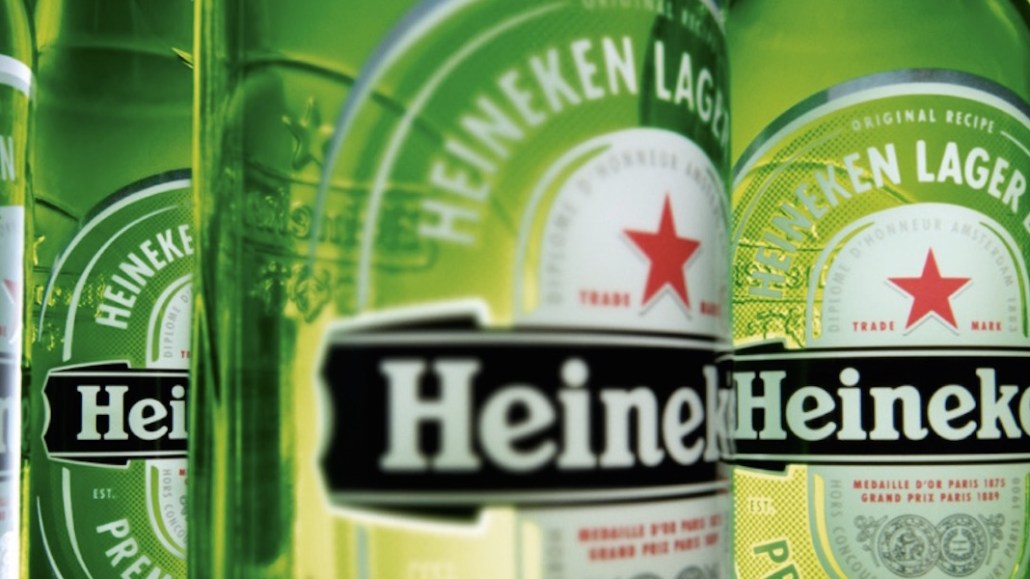Heineken prioritizes mass reach over hypertargeting on Google and Facebook

Heineken is shifting dollars from TV to Google and Facebook as the digital platforms become the new preferred way to reach mass audiences.
The brewer is rethinking the role of platforms long touted for their ability to deliver highly personalized messages. Digital (especially Google and Facebook) is a mass medium for Heineken, and as such, it’s increasingly using them to reach the most people in a broad target demographic.
Similar to how Procter & Gamble said it’s fine-tuning how it’s using Facebook to target potential customers, Heineken doesn’t think reach versus targeting is an either-or question; it’s just seeking the right balance. In some markets, that’s meant spending more on digital than it does on TV, according to Nourdin Rejeb, Heineken’s global manager for digital.
Rejeb said Heineken is increasingly inclined to spend most of its media budget with Facebook and Google, albeit with wider parameters for ad targeting. He said the brewer has viewed both platforms as mass reach channels for some time but that it’s getting more focused than ever on reach.
“We’re seeing in some cases digital spend is overtaking TV spend like a lot of brands because we’re realising that’s where consumers are spending most of their time,” Rejeb said. “That’s not to say TV isn’t important to us because it is; it’s just that the increase is definitely going to the digital.”
Most big brands like Heineken have gone from viewing advertising on Facebook and YouTube as a way to spur conversation around viral content to using it to catch hundreds of millions of people’s attention. While the scale is now there on these platforms (Facebook has around 2 billion monthly users), the brewer has struggled to get its ads viewed on the social network.
In the U.S., for example, many of Heineken’s videos on Facebook are viewed for less than three seconds. To counter this, Heineken has pushed all its messaging to the start of videos to get people to stop scrolling. The brewer is trying to limit its Facebook ads to six seconds, the length that Facebook has said is ideal, citing a recent test with Tropicana.
Today’s ad climate has many brands questioning whether they have overspent on digital. P&G made headlines when it axed $140 million worth of digital ads in the last quarter, questioning the ads’ effectiveness. Still, the brewer is upping its spend with Facebook and Google, saying they provide creative support.
“They obviously want our money as well, but the work we’re doing with both is working,” Rejeb said. “For us, those two partners are very critical.”
Heineken also is spending more time learning how its ads can capture people’s attention. To that end, it’s investing in ad and marketing tech. It’s building an ad server that will let it reserve large amounts of inventory directly from publishers or ad networks. It also plans to build a data-management platform where it can access and manage data, such as cookie IDs and mobile identifiers, to create targeting segments for its ad campaigns.
More in Media

From sidelines to spotlight: Esports events are putting creators center stage
Esports events’ embrace of content creators reflects advertisers’ changing priorities across both gaming and the wider culture. In the past, marketers viewed esports as one of the best ways to reach gamers. In 2025, brands are instead prioritizing creators in their outreach to audiences across demographics and interest areas, including gaming.

Condé Nast and Hearst strike Amazon AI licensing deals for Rufus
Condé Nast and Hearst have joined the New York Times in signing a licensing deal with Amazon for its AI-powered shopping assistant Rufus.

Media Briefing: AI payouts may be entering a new era
AI compensation is evolving — and new models, not just publisher demands, are driving the shift beyond flat-fee licensing.







